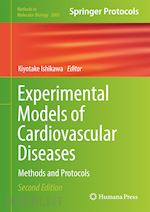
Questo prodotto usufruisce delle SPEDIZIONI GRATIS
selezionando l'opzione Corriere Veloce in fase di ordine.
Pagabile anche con Carta della cultura giovani e del merito, 18App Bonus Cultura e Carta del Docente
This second edition provides new and updated methods for establishing reliable and reproducible experimental models of cardiovascular diseases. Chapters detail practical protocols from expert laboratories focusing on cardiovascular research, that would be critical in exploring novel discoveries in cardiac biology, and the development of effective therapeutic approaches. Written in the highly successful Methods in Molecular Biology series format, chapters include introductions to their respective topics, lists of the necessary materials and reagents, step-by-step, readily reproducible laboratory protocols, and key tips on troubleshooting and avoiding known pitfalls.
Authoritative and cutting-edge, Experimental Models of Cardiovascular Diseases: Methods and Protocols, Second Edition aims to provide detailed and practical protocols that will be valuable tools for researchers in cardiology to conduct their research.
Decellularized extracellular matrix for modelling cardiac extracellular microenvironment.- Subtype and lineage- mediated protocol for standardizing activin/nodal and BMP signaling for hiPSC-derived cardiomyocyte differentiation.- Generation of 3D-multicellular human iPSC-heart organoids for the non-invasive assessment of cardiac fibrosis.- In vitro experimental approach for studying human pulmonary artery smooth muscle cells and endothelial cells proliferation and migration.- Culturing cardiac tissue slices under continuous physiological mechanical stretches.- Quantitative assessment of mitochondrial morphology and electrophysiological function in the diabetic heart.- Ex vivo working porcine heart model.- Conventional Method of Cardiac Ischemia/Reperfusion Injury in Mice.- Rat model of Isoproterenol-induced myocardial injury.- Pop-out Myocardial Infarction Induction in Mice.- Rat Models of Cardiorenal Syndrome and Methods for Functional Assessment.- The Sugen/Hypoxia rat model for pulmonary hypertension and right heart failure.- Unilateral lung removal in combination with monocrotaline or SU5416 in rodents: a reliable model to mimic the pathology of the human pulmonary hypertension.- Swine model of myocardial infarction induced by ischemia-reperfusion and embolization.- Porcine Model of Hypertrophy-Independent Left Ventricular Stiffening via Repetitive Pressure Overload.- Swine model of coronary artery dissection.- Hypoxia-induced piglet model of cardiac arrest with assisted resuscitation by extracorporeal membrane oxygenation.- A dynamic sheep model to induce pulmonary hypertension and right ventricular failure.











Il sito utilizza cookie ed altri strumenti di tracciamento che raccolgono informazioni dal dispositivo dell’utente. Oltre ai cookie tecnici ed analitici aggregati, strettamente necessari per il funzionamento di questo sito web, previo consenso dell’utente possono essere installati cookie di profilazione e marketing e cookie dei social media. Cliccando su “Accetto tutti i cookie” saranno attivate tutte le categorie di cookie. Per accettare solo deterninate categorie di cookie, cliccare invece su “Impostazioni cookie”. Chiudendo il banner o continuando a navigare saranno installati solo cookie tecnici. Per maggiori dettagli, consultare la Cookie Policy.